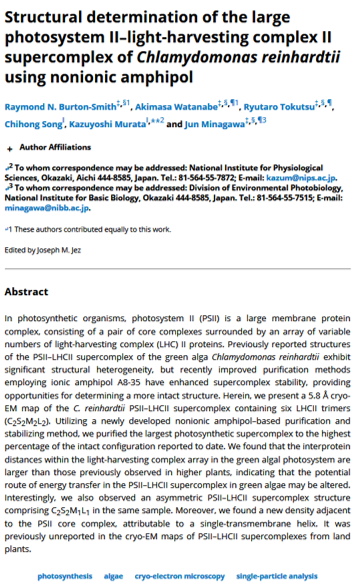08.11.2019
Structural determination of the large photosystem II–light-harvesting complex II supercomplex of Chlamydomonas reinhardtii using nonionic amphipol
The Journal of Biological Chemistry 294, 2019
Abstract
In photosynthetic organisms, photosystem II (PSII) is a large membrane protein complex, consisting of a pair of core complexes surrounded by an array of variable numbers of light-harvesting complex (LHC) II proteins. Previously reported structures of the PSII–LHCII supercomplex of the green alga Chlamydomonas reinhardtii exhibit significant structural heterogeneity, but recently improved purification methods employing ionic amphipol A8-35 have enhanced supercomplex stability, providing opportunities for determining a more intact structure. Herein, we present a 5.8 Å cryo-EM map of the C. reinhardtii PSII–LHCII supercomplex containing six LHCII trimers (C2S2M2L2). Utilizing a newly developed nonionic amphipol–based purification and stabilizing method, we purified the largest photosynthetic supercomplex to the highest percentage of the intact configuration reported to date. We found that the interprotein distances within the light-harvesting complex array in the green algal photosystem are larger than those previously observed in higher plants, indicating that the potential route of energy transfer in the PSII–LHCII supercomplex in green algae may be altered. Interestingly, we also observed an asymmetric PSII–LHCII supercomplex structure comprising C2S2M1L1 in the same sample. Moreover, we found a new density adjacent to the PSII core complex, attributable to a single-transmembrane helix. It was previously unreported in the cryo-EM maps of PSII–LHCII supercomplexes from land plants.
Burton-Smith et al. (2019) overcome the dissociation of the membrane-extrinsic polypeptides of the PSII–LHCII supercomplex, that was likely caused by the ionic nature of A8-35, by applying non-ionic amphipol NAPol, a product of our partner company Anatrace.
>> View article


